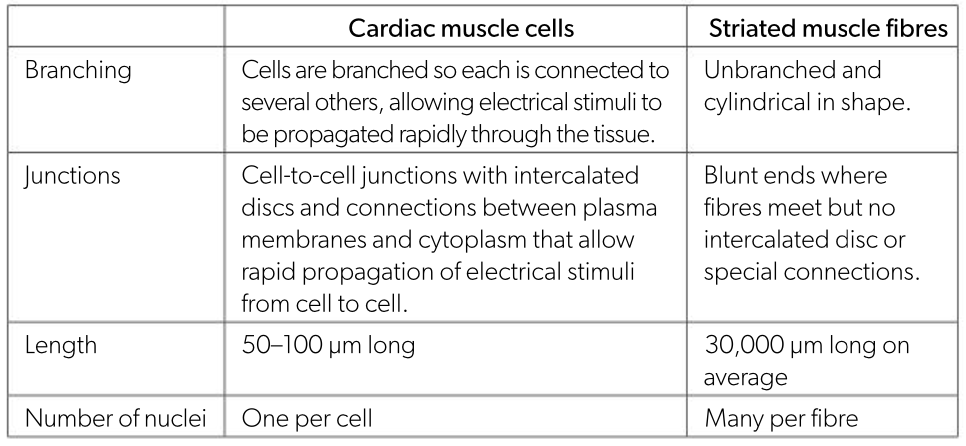B2.3: Cell specialisation
1/8
Earn XP
Description and Tags
2025 New syllabus
Name | Mastery | Learn | Test | Matching | Spaced |
|---|
No study sessions yet.
9 Terms
What are the adaptations of cardiac muscle cells and striated muscle fibres
Muscle tissues exerts pulling forces as it contracts.
Striated muscles: attached to the skeleton. contraction --> exerts force on bone to maintain or change posture. (I.E. locomotion or for ventilation).
Muscles have: enclosed plasma membrane but many nuclei.
Both cardiac muscle and skeletal striated muscles have:
• Contractile myofibrils.
• Large amount of mitochondria --> supplies the ATP for contraction.

Outline the - Adaptations of sperm and egg cells
Eggs cell and sperm - Adaptations:
Mall gametes:
Motile (both plants and animals).
produced in high number: increase chances of fertilisation.
Tail - swims fast to fertilise eggs.
Small
Contains acrosome enzymes to digest Zona pellucida.
Female gametes:
• Big: nutritents and food reserves: for possible embryo development.
acrosome reaction mechanism: allows only one sperm to penetrate;
• Zona pellucida: tough and hard protecting the egg; restrict sperm entry. (Crotical genules hardens the Zona pellucida)
both are: Haploid cells (23n)
How do cells become differentiated?
Differentiation is the process during development whereby newly formed cells become more specialised and distinct from one another as they mature.
All cells share an identical genome – each cell contains the entire set of genetic instructions for that organism
The activation of different instructions (genes) within a given cell by chemical signals will cause it to differentiate into different cell types
Why is the SA:V ratio different in each organism?
The exhange of materials from the external environment is needed for chemical reactions in organisms. (differs in different organimsm).
The rate of metabolism of a cell is a function of its Mass:V (larger cells need more energy to sustain essential functions)
The rate of material exchange is a function of its SA:V (large membrane surface equates to more material movement)
As a cell grows, volume (units3) increases faster than surface area (units2), leading to a decreased SA:Vol ratio
If metabolic rate exceeds the rate of exchange of vital materials and wastes (low SA:Vol ratio), the cell will eventually die
Hence ,growing cells tend to divide and remain small in order to maintain a high SA:Vol ratio suitable for survival.
Cell size in specialisation
The size of cells can vary significantly in multicellular organisms in order to optimise the specific function of a cell
RBCs need to squeeze through narrow capillaries and have a diameter of only 7–8 µm
Neurons need to transmit signals throughout the body and can be over 1m in length (but with a width of only ~10 µm)
Striated muscle fibres consist of fused muscle cells – they can have a width of 20–100 µm and a length of up to 12 cm
A human ovum (female egg) is one of the largest cells with a diameter of 120 µm, while the male sperm is extremely small (~5 µm)
Link: Cell Size and Scale
Totipotent
Can form any cell type, including embryonic cells, and develop into entirely new organisms
embryonic stem cells
Pluripotent
– Can form any cell type arising from the three germ layers
embryonic stem cells
Multipotent
Can only form a number of closely related cell types
Adult stem cells.
Location and function of stem cell niches in adult humans
Stem cell niches are sites within the body where a pool of adult stem cells are maintained in preparation for future proliferation and differentiation
Locations of stem cell niches in the human body include the bone marrow, hair follicles, heart, intestines and brain
Bone Marrow
Haemopoietic stem cells are located within the bone marrow and give rise to the different types of blood cells (e.g. erythrocytes, leucocytes and thrombocytes)
Bone marrow transplants are commonly employed to replace the haemopoietic stem cell niche following chemotherapy for leukemia (blood cell cancer)
Hair Follicles
contain a range of epidermal stem cells that are involved in cyclic bouts of hair growth, skin innervation, vascularisation and wound repair
These stem cells could potentially be harvested and used to regenerate skin tissue in burns victims (or stimulated to promote hair regrowth in bald individuals)